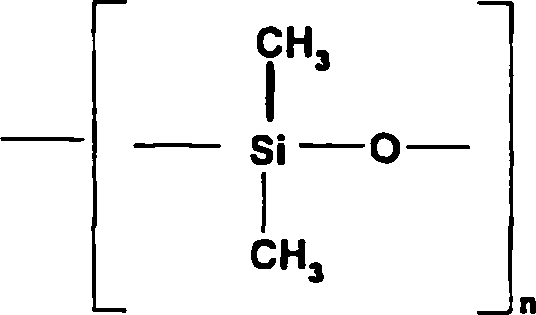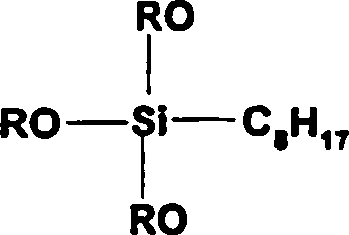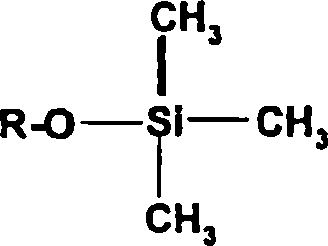Adhesive and sealant systems
A sealant and adhesive technology, applied in non-polymer adhesive additives, adhesive additives, etc., can solve problems such as limited use
- Summary
- Abstract
- Description
- Claims
- Application Information
AI Technical Summary
Problems solved by technology
Method used
Image
Examples
Embodiment 1
[0191] Example 1: Epoxy-based adhesive
[0192] The AEROSIL(R) substance used is a fumed silica:
[0193] -AEROSIL(R) 202
[0194] - AEROSIL® R 202 VV 60
[0195] -AEROSIL(R) 202 VV 90
[0196] The test formulations for epoxy resins were:
[0197] Component A (resin component): 94.4% Araldit M (bisphenol A resin)
[0198] 5.6% AEROSIL(R) 202 (fumed silica)
[0199] Component B (hardener component): 90.9% Euredur 250 (polyaminoamide hardener)
[0200] 9.1% HY960 (quaternary amine as accelerator)
[0201] step:
[0202] Add silica directly to epoxy resin. The silica was completely wetted with the resin in a high speed laboratory mixer (5 cm diameter, Cowles pan) at 1000 rpm. Measure the mixing time. Disperse in a high-speed laboratory mixer at 3000 rpm for 5 minutes. The sample is then ventilated. Store the resin / silica mixture at 25 °C for 1.5 h, then add the hardener component at 1000 rpm, heat to 25 °C for 1 min, and rotate with...
Embodiment 2
[0207] Example 2: Epoxy-based adhesive
[0208] The AEROSIL(R) substance used is a fumed silica:
[0209] -AEROSIL(R) 202
[0210] - AEROSIL® R 202 VV 60
[0211] -AEROSIL(R) 202 VV 90
[0212] - AEROSIL® R 805
[0213] - AEROSIL® R 805 VV 60
[0214] - AEROSIL® R 805 VV 90
[0215] step:
[0216] The test formulations for epoxy resins were:
[0217] Component A (resin component): 92.0% Araldit M (bisphenol A resin)
[0218] 8.0% AEROSIL(R) 202 (fumed silica)
[0219] Component B (hardener component): 90.9% Euredur 250 (polyaminoamide hardener)
[0220] 9.1% HY 960 (quaternary amine as accelerator)
[0221]Add silica directly to epoxy resin. The silica was completely wetted with the resin in a high speed laboratory mixer (5 cm diameter, Cowles pan) at 1000 rpm. Measure the mixing time. Disperse in a high-speed laboratory mixer at 3000 rpm for 5 minutes. The sample is then ventilated. Store the resin / silica mixture at 25 °C for...
Embodiment 3
[0227] Weigh out the Desmoseal M 100 followed by the Mesamoll. Dynasylan Glymo was added followed by homogenization with a high speed laboratory mixer at 1000 rpm. Add OmyaBLP-3 and homogenize with a high speed mixer at 1000 rpm. Add AEROSIL(R). Homogenize with a high speed mixer at 1000 rpm and disperse in vacuum at 3000 rpm for 10 minutes. Rheological properties were determined at 25°C and flow behavior was determined according to ASTM-D-2202. In this test, the sealant is introduced into a standardized test block and stored in a vertical position at room temperature. The distance traveled by the lower side of the sealant in the block is measured in mm.
[0228] The AEROSIL(R) substance used is a fumed silica:
[0229] -AEROSIL(R) 202
[0230] - AEROSIL® R 202 VV 60
[0231] -AEROSIL(R) 202 VV 90
[0232] A simple one-component polyurethane sealant formulation based on Desmoseal M 100 was used for the examples, it is also possible to prepare polyurethane adhesives usi...
PUM
| Property | Measurement | Unit |
|---|---|---|
| melt flow index | aaaaa | aaaaa |
Abstract
Description
Claims
Application Information
 Login to View More
Login to View More - R&D
- Intellectual Property
- Life Sciences
- Materials
- Tech Scout
- Unparalleled Data Quality
- Higher Quality Content
- 60% Fewer Hallucinations
Browse by: Latest US Patents, China's latest patents, Technical Efficacy Thesaurus, Application Domain, Technology Topic, Popular Technical Reports.
© 2025 PatSnap. All rights reserved.Legal|Privacy policy|Modern Slavery Act Transparency Statement|Sitemap|About US| Contact US: help@patsnap.com



